
94% of researchers rate our articles as excellent or good
Learn more about the work of our research integrity team to safeguard the quality of each article we publish.
Find out more
ORIGINAL RESEARCH article
Front. Earth Sci., 03 February 2022
Sec. Economic Geology
Volume 10 - 2022 | https://doi.org/10.3389/feart.2022.829035
This article is part of the Research TopicAdvances in the Exploration and Development of Unconventional Oil and Gas: From the Integration of Geology and EngineeringView all 32 articles
The geological characteristics of shale and the gas composition and carbon isotopic variation from the shale are very important indicators for the shale gas study. This article analyzed the geological characteristics of Cambrian Niutitang shale and focused on the gas composition and carbon isotopic characteristics of the shale gas from the Cambrian Niutitang Formation. We can see that the total organic carbon content ranges from 0.41 to 4.29%, with an average of 1.65%, which is mainly type I and Ⅱ1. The thermal maturity of sample ranges from 1.98 to 2.53%, with an average of 2.30%, which is in the postmature stage of thermal evolution. The Cambrian Niutitang Formation shale gas in the southern margin of the Hannan ancient uplift is the high-quality hydrocarbon gas methane that takes an absolute majority with a content ranging from 89.60 to 99.19% with an average of 96.46%. The wetness of the gas from the study area ranges from 0.06 to 0.42%, with only 0.25% on an average, which is defined as typical dry gas. The distribution of carbon isotope values has partial “reverse” characteristics that are δ13C1 > δ13C2 and δ13C2 < δ13C3. The natural gas of Niutitang Formation in the study area belongs to thermogenic gas. At the same time, it is found that some data points are beyond the range of thermogenic gas, which is mainly due to the low-humidity and heavy carbon isotope value of methane caused by the high maturity of source rock. In the study area, the Niutitang Formation natural gas carbon isotope values are located in Zone III with the characteristics of mixed reversal gas in the δ13C1-δ13C2 part.
Cambrian Niutitang Formation organic-rich shale is a set of main shale strata in southern China, and shale gas has been found and broken through in many areas. This set of shale strata is also widely developed in the southern margin of Hannan ancient uplift and is an important field of shale gas survey and exploration in the future.
The gas composition of shale gas wells mined in China and North America shows that shale gas is mainly methane, containing a small amount of ethane and propane, and other non-hydrocarbon gas components are less (Zumberge et al., 2009, Zumberge et al., 2012). The composition and relative content of hydrocarbon gas are obviously closely related to the thermal evolution of organic matter. Shale gas is mostly dry gas in high-overmature shale, while the carbon isotope inversion has become a typical feature of some shale gas fields and attracted more and more attention (Ellis et al., 2003; Xia and Tang, 2012). One of the reasons is that most of the gas wells with carbon isotope inversion are medium- and high-production wells (Han et al., 2013).
In order to understand the formation conditions and characteristics of natural gas in Cambrian Niutitang Formation of SND1 well in the study area, it is necessary to conduct in-depth research on the geochemical characteristics and natural gas genesis of Cambrian Niutitang Formation in the study area (Dai et al., 2003). In order to clarify the origin of natural gas in Niutitang Formation in this area, a reliable judgment can be made by studying the carbon isotope series and inversion of alkane gas. At the same time, a strong judgment can be further made for the origin of natural gas in this area according to the relationship between carbon isotope of alkane gas and alkane gas components and the relationship between the methane carbon isotope and hydrogen isotope (Whiticar, 1999; Liu et al., 2016).
This article analyzed the geological characteristics of Cambrian Niutitang shale and focused on the gas composition and carbon isotopic characteristics of the shale gas from the Cambrian Niutitang Formation to obtain deep insights into the genesis of shale gas, the reasons for isotopic reversal, and shale gas enrichment mechanism (Li et al., 2020).
The Micangshan–Hannan uplift is tectonically located at the northwestern margin of the Upper Yangtze Plate, adjacent to the Longmenshan tectonic belt in the west, and separated by the Dabashan arc belt in the east (Tian et al., 2021). The study area, Huijunba syncline is between Micangshan uplift and Hannan uplift, whose western section is relatively open, and gradually converges into an arc toward the northeast (Chen et al., 2018). The tectonic line of Huijunba syncline is nearly east–west trending, which consists of several suborder anticlines (Liu et al., 2021). In the study area, the Early Paleozoic strata are fully developed, whereas the Devonian and Carboniferous strata are absent in the Late Paleozoic strata, and the Permian and Triassic strata are mainly exposed. The Lower Cambrian Niutitang Formation was mainly formed in a shallow shelf environment and partly in a coastal or supratidal environment, which is exposed only in the margin of the uplift (Yu et al., 2011; Liu et al., 2021). The average thickness of the shale in the Niutitang Formation is mainly more than 100 meters, which has the characteristics of high total organic carbon content, low thermal maturity, and shallow burial depth (Tian et al., 2019). The lithology of Niutitang Formation shale mainly consists of black shale and calcareous mudstone, which acted as the favorable shale gas reservoir section (Figure 1).
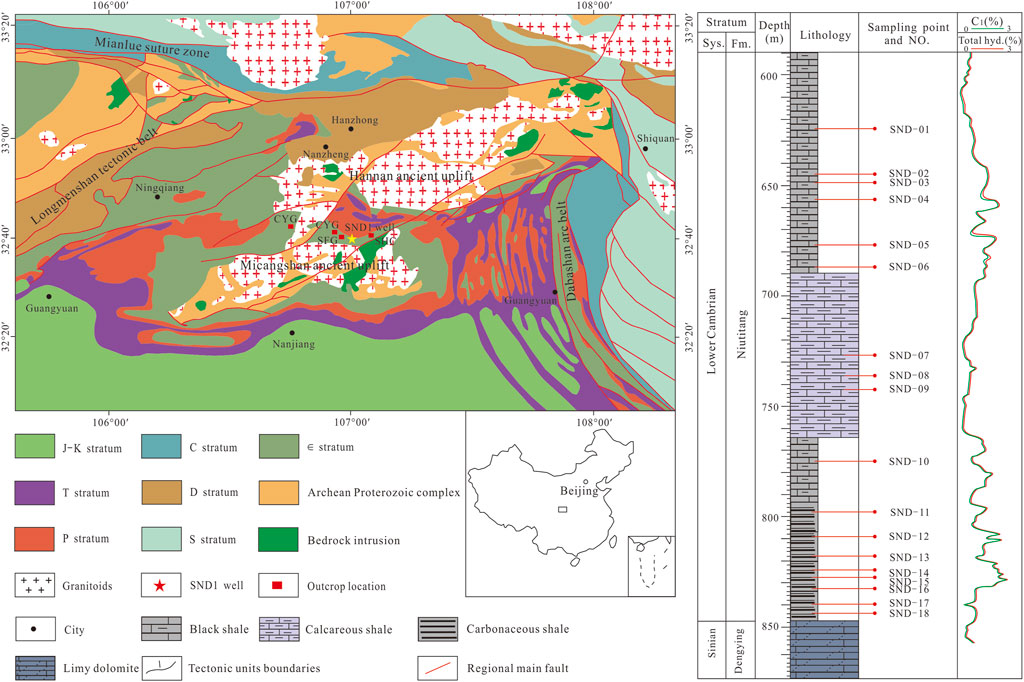
FIGURE 1. Geological map of the study area and stratigraphic column of the Niutitang Formation (Fm.) of SND1 well and sampling positions. Sys, system; Total hyd, total hydrocarbon.
We studied the Niutitang Formation black shales from SND1 well and outcrop samples in the southern Shaanxi region. The Niutitang Formation in SND1 well is about 280 m thick (Figure 1). A total of 30 core and outcrop samples were collected for thermal maturity (Ro, %), total organic carbon (TOC, %), and organic matter type test, and 18 core samples of SND1 well were collected for the gas content test (fielding desorption test), gas composition, and organic carbon isotope studies.
Total organic carbon abundances were measured using a LECO CS230 carbon and sulfur analyzer adopting dry combustion in Yangtze University. The samples were ground to less than 200 mesh size and washed with acid (HCl) to expel carbonate minerals at 60°C for 24 h, then distilled water was used to eliminate treated HCl, and samples were oven-dried at 50°C for 24 h. The organic matter was measured using a Zeiss Axio Scope.A1/J&M Msp 200 as a complement to vitrinite reflectance (VRo) and bitumen reflectance (BRo) measurements that are more conventionally used for maturity analysis.
The chemical compositions (CH4, C2H6, C3H8, CO2, and N2) were determined using a 7890A gas chromatograph (GC) equipped with a thermal conductivity detector and a flame ionization detector.
The carbon and hydrogen isotopes data were determined using a 7890A gas chromatograph and an IsoPrime 100 Gas temperature isotope mass spectrometer by the GC/TC/IRMS system method. The detection ambient temperature is 22°C, and the humidity is 65%.
A total of 18 samples from SND1 well were analyzed in the field, and the residual gas content was measured in the laboratory, and the lost gas content was calculated by the linear regression analysis method. During the gas content test process, core samples were moved into a transparent sealed tank filled with saturated salt water, and then the sealed tank was placed in a constant temperature water bath of 60°C for gas resolution at reservoir temperature (55°C). The shale was resolved for 72 h to ensure that the gas in the shale was fully resolved. After the analysis is completed, the gas is collected, and the volume of the gas is measured.
Organic matter abundance (TOC) is not only the material basis of shale gas production but also affects the total gas accumulation in shale gas reservoirs. The organic carbon content ranges from 0.41 to 4.29%, with an average of 1.65%. Specifically, the average of TOC for outcrop and well samples is 1.22 and 1.94%, respectively. Kerogen microscopy identification and kerogen carbon isotope results show that the organic matter in the Niutitang shale is mainly type I, and some samples are type II1. The thermal maturity of sample ranges from 1.98 to 2.53%, with an average of 2.30%. Therefore, the shale of Niutitang Formation is in the postmature stage of thermal evolution (Table 1). Compared with the characteristics of high maturity of marine shale in Niutitang Formation in southern China, the maturity of samples in this study is relatively moderate, which is speculated to be related to the proximity of Hannan uplift, which is more favorable for the preservation of shale gas (Zhai et al., 2018; Xu et al., 2020a).
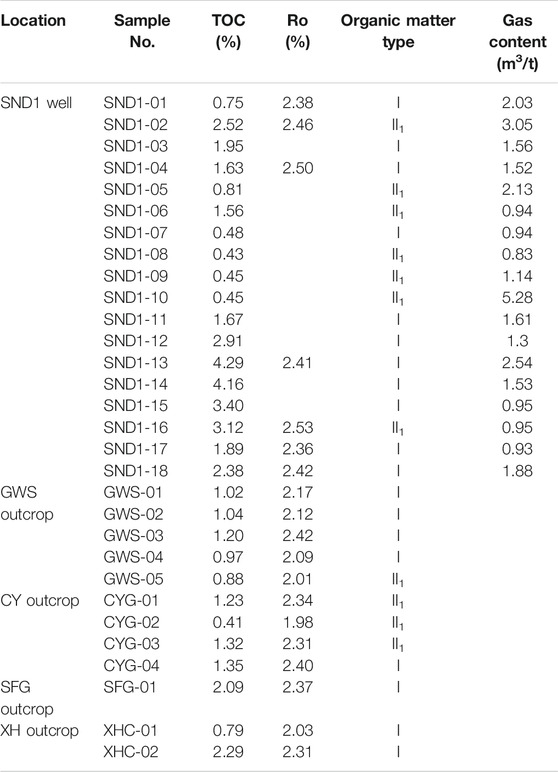
TABLE 1. Organic geochemical characteristics and gas content of the Niutitang Formation shale gas in the study area.
The field analytical gas content of SND1 well is between 0.04 m3/t and 0.91 m3/t, with an average of 0.40 m3/t. The total gas content is 0.83–5.28 m3/t, with an average of 1.73 m3/t. The total gas content is not very high which may be caused by shallow burial depth and poor preservation conditions (Table 1).
The natural gas of the Cambrian Niutitang Formation in the southern margin of the Hannan ancient uplift is the high-quality hydrocarbon gas methane that takes an absolute majority with a content ranging from 89.60 to 99.19% with an average of 96.46%, which is similar to that of the Fuling (average of 98.16%), Changning (average of 98.69%), and Weiyuan (average of 98.01%) areas (Liu, 2015; Wu et al., 2015; Feng et al., 2016). The ethane content is extremely low with 0.24% on an average, which is similar to that of Fuling (average of 0.69%), Changning (average of 0.49%), and Weiyuan (average of 0.46%) areas (Liu, 2015; Wu et al., 2015; Feng et al., 2016; Xu et al., 2020b). Almost no propane and other heavy hydrocarbon components were present. The wetness ((C2- C5)/ (C1- C5)) of the gas from the study area ranges from 0.06 to 0.42%, with only 0.25% on an average, which is defined as typical dry gas. The content of non-hydrocarbon gases such as CO2 and N2 is very low, and the average content accounts for only 2.15 and 1.15%, respectively. No hydrogen sulfide and other gases were detected in the shale gas of Niutitang Formation in the study area (Table 2).
The carbon isotopic value of methane (δ13C1) of natural gas from Niutitang Formation shale in the study area ranges between -37.6‰ and -31.3‰ with an average of -35.56‰. The carbon isotopic value of ethane (δ13C2) of natural gas ranges between -38.4‰ and -34.8‰ with an average of -37.7‰. The carbon isotopic value of propane (δ13C3) of natural gas ranges between -38.2‰ and -34.3‰ with an average of -36.86‰ (Table 2). The distribution of carbon isotope values of methane, ethane, and propane has partial “reverse” characteristics that are δ13C1 > δ13C2 and δ13C2 < δ13C3 (Figure 2).
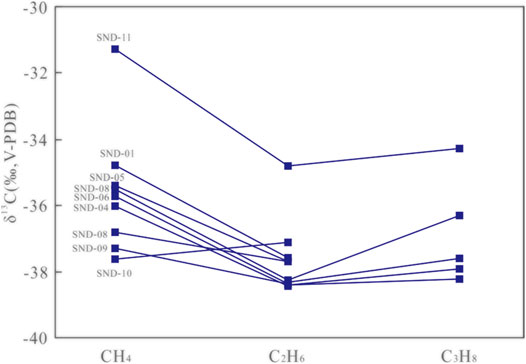
FIGURE 2. Distribution characteristics of the carbon isotopic composition of the Niutitang Formation shale gas in the study area. See Figure 1 for sample locations.
The genetic types of natural gas can be divided into inorganic genetic gas, organic genetic gas, and mixed genetic gas. Inorganic gas is generally related to the deep activities of the earth and usually has the following distinguishing features: 1) the carbon isotopic composition characteristics of inorganic genetic gas with δ13C1 > δ13C2 > δ13C3; 2) the carbon isotope value of methane is generally more than -30‰ (Dai et al., 2008) or -25‰ and -20‰; 3) the carbon dioxide content is more than 60%; and 4) the carbon isotope content of carbon dioxide is more than -8‰ (Dai et al., 2008). Although the distribution of carbon isotope values of methane, ethane, and propane has partial “reverse” characteristics that are δ13C1 > δ13C2 and δ13C2 < δ13C3 (Figure 2), due to the δ13C1 is far less than -30‰ and the CO2 content is far less than 60%, which shows the characteristics of the alkane gas in Niutitang Formation shale in the study area with organic genetic gas.
The organic gas can be divided into biogenic gas, pyrolytic gas, and cleavage gas according to the thermal maturity of organic matter. According to δ13C1-C1/C2+3 parameters, Whiticar compiled the genetic identification chart of natural gas (Whiticar, 1999). Put the δ13C1 value and the calculated C1/C2+3 value from the Table 2 into the chart, and it is judged that the natural gas of Niutitang Formation in the study area belongs to thermogenic gas. At the same time, it is found that some data points are beyond the range of thermogenic gas, which is mainly due to the low-humidity (average 0.25%) and heavy methane carbon isotope value (average -35.56‰) caused by the high maturity of source rock (average Ro = 2.30%) (Liu et al., 2016; Zhang et al., 2016; Gou et al., 2019). Therefore, the shale gas of Niutitang Formation in the study area is organic high-temperature pyrolysis gas (Figure 3).
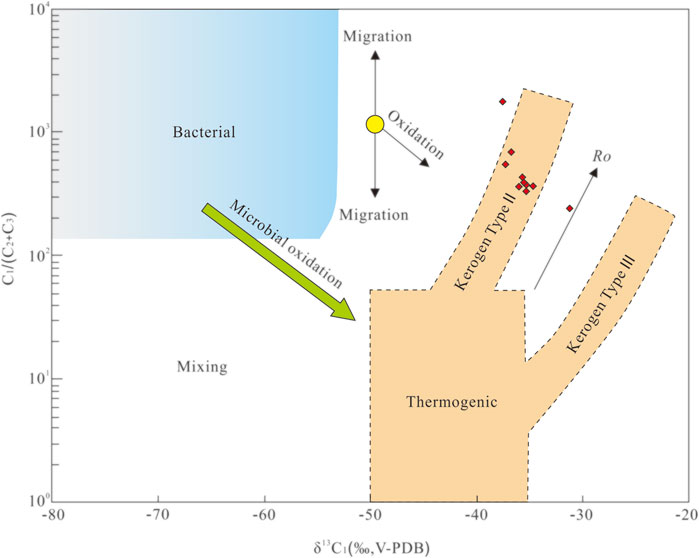
FIGURE 3. Geochemical classification showing the genesis of shale gas in the study area (after Whiticar, 1999).
Organic thermogenic natural gas is mainly divided into oil-type gas and coal-type gas (Dai et al., 1992). Some scholars listed the carbon isotope identification indicators of alkane gas with condensate oil and crude oil or their homologous components (Table 3). These indicators are common indicators in gas source correlation with high reliability. The carbon isotope of natural gas in the study area is with - 37.60‰ ≤ δ13C1 ≤ −31.30‰,−38.40‰ ≤ δ13C2 ≤ −34.80‰ and -38.20‰ ≤ δ13C3 ≤ −34.30‰, which is characterized by oil-type gas. Put the δ13C1 and δ13C2 value into the chart (Gang et al., 1997), and the data points also fall within the oil-type gas range (Figure 4).

TABLE 3. Identification items of carbon isotopes and composition (after Dai et al., 1992).
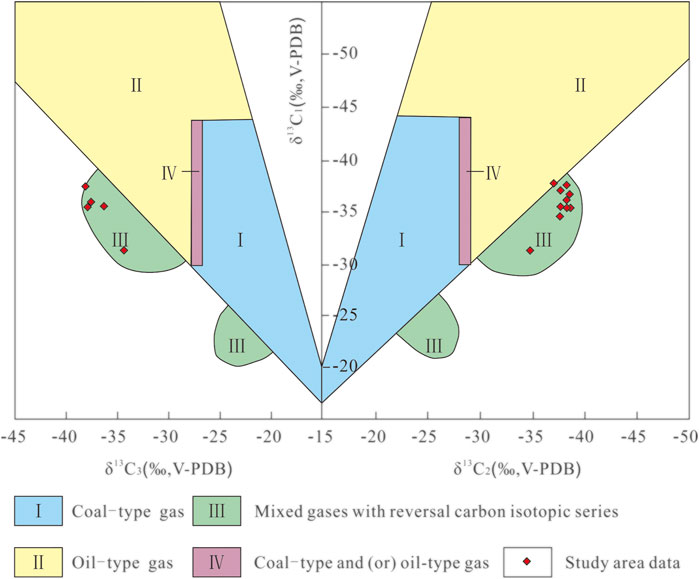
FIGURE 4. Identification chart of δ13C1–δ13C2–δ13C3 for the Niutitang Formation shale gas in the study area (after Dai et al., 1992).
Using δ13C1, δ13C2, and δ13C3 values from a large amount of oil-type gas and coal-type gas in many oil and gas fields around the world, the predecessor compiled and improved the chart for distinguishing the coal-type gas and oil-type gas (Dai et al., 2014a; Feng et al., 2016). Put the value from the Table 2 into the chart and found that the carbon isotope values of Niutitang Formation natural gas in the study area are within the Zone III which represents the mixed reversal gas zone in the δ13C1–δ13C2 part (Figure 4). However only a few data points are within the Zone III, while most other data points are not within any gas zone, but close to the mixed reversal gas zone in the δ13C1–δ13C3 part (Figure 4). According to the investment results, the δ13C1, δ13C2, and δ13C3 values of natural gas from Niutitang Formation in the study area are not located in Zone I and IV, which generally reflects that the gases are not coal-type gas. At the same time, it also shows that the natural gas data points of Niutitang Formation in the study area are not completely included in the I-V gas zone in the chart, which may indicate that the carbon isotope of shale gas has its particularity with conventional natural gas.
Generally, the primary negative carbon isotope sequence is δ13C1 < δ13C2 < δ13C3. However, in recent years, including natural gas in the study area, more and more phenomena of carbon isotope reversal have been discovered such as δ13C1 > δ13C2 pervasively exists in organic origin gas (Figure 5). This phenomenon is common in these areas such as the Longmaxi Formation shale gas in Changning, Fuling, and Weiyuan areas of Sichuan Basin, China (Dai et al., 2014b; Feng et al., 2016; Qin et al., 2017), the Songkan Formation and Niutitang Formation shale gas in the middle Yangtze area, China (Zhang et al., 2018), the Permian shale gas in the north of South China (Liu et al., 2018), the Mississippian Barnett and Fayetteville shale gas from the Fort Worth and Eastern Arkoma basins, North America (Zumberge et al., 2012; Li et al., 2020), and Horn River shale gas at the western edge of the Western Canada basin (Tilley et al., 2011; Li et al., 2020).
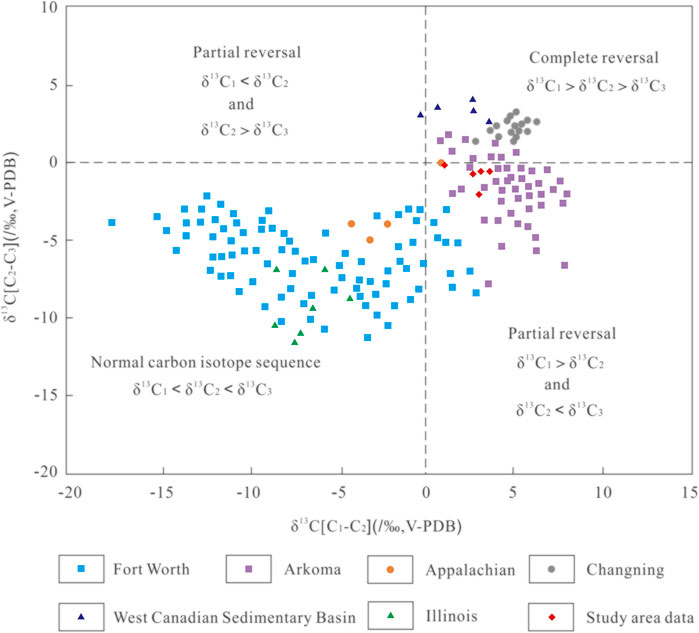
FIGURE 5. Reversal distribution mode of carbon isotopic composition of shale gas (modified from Zumberge et al., 2012; Tilley and Muehlenbachs, 2013; Hao and Zou, 2013; Liu, 2015; Wu et al., 2015; Feng et al., 2016).
There has always been controversy about the origin of carbon isotope inversion. The main viewpoints are as follows: 1) the mixing of gases in different periods of homology (Zumberge et al., 2012; Hao and Zou, 2013). For example, high-maturity natural gas is mixed with early residual 12C-rich ethane, resulting in lighter carbon isotopic composition of ethane and δ13C1 > δ13C2 partial inversion. 2) The mixture of kerogen pyrolysis gas and asphalt, retained oil, wet gas pyrolysis gas in the high-evolution stage, and the pyrolysis gas produced by retained oil or asphalt will produce lighter ethane (12C-rich) (Tang et al., 2000; Xia and Tang, 2012; Hao and Zou, 2013; Tilley and Muehlenbachs, 2013; Xia et al., 2013). 3) Water and other substances participate in the redox reaction (Burruss and Laughrey, 2010; Zumberge et al., 2012; Gao et al., 2014). 4) Isotope fractionation caused by hydrocarbon expulsion and diffusion. Methane rich in 12C will be preferentially lost in the diffusion process, resulting in the enrichment of 13C in residual methane and the heavier carbon isotope composition (Qin et al., 2016, 2017). There is no consensus on the cause of carbon isotope inversion, but it may not be caused by one factor but by multiple factors.
According to the previous discussion on the genesis of shale gas, we believe that the carbon isotope inversion of shale gas in Niutitang Formation in the study area is mainly caused by the mixing of natural gas produced by the degradation of highly mature kerogen and residual crude oil pyrolysis gas. With the increase of maturity, crude oil begins to crack gradually, crude oil–cracking gas accounts for an increasing proportion in the mixture, and the carbon isotopes of methane and ethane begin to lighten gradually (Xia et al., 2013). However, due to the high C2 + content in oil-cracked gas, ethane is enriched in a large number of light isotopes (12c) faster. With the continuous improvement of maturity, the light carbon isotopes of methane and ethane are enriched. Therefore, the carbon isotope of methane is heavier than that of ethane, and the carbon isotope is reversed.
However, only the secondary cracking of moisture may not be completely reversed. Previous thermal simulation tests in the closed system show that carbon isotope inversion is unlikely to occur in pure thermogenic shale gas (Qu et al., 2016), so other factors must play a role. Other factors may include the reaction of ethane with water and ferrous metals under Rayleigh fractionation. In addition, high ground temperature conditions may also be one of the important influencing factors.
The study confirmed that the shale of the Cambrian Niutitang Formation in the study area is rich in natural gas, and the source of natural gas is not only related to the discovered natural gas whether it is shale gas or not but also has an important impact on the next exploration deployment. It is found that there are mainly two sets of source rocks in the study area, namely Lower Cambrian Niutitang Formation black carbonaceous shale and Lower Silurian Longmaxi Formation black graptolite shale.
According to the relevant data of formation pressure, there is a certain overpressure in the Cambrian Niutitang Formation in the study area, while other overlying strata do not develop overpressure (Chen et al., 2018). Therefore, the natural gas generated by these sets of source rocks cannot migrate downward to Niutitang Formation and form overpressure. According to the drilling logging and geological profile survey results, the thickness of the shale of Niutitang Formation in the study area is more than 100 m, and the average value of organic carbon reaches 1.65%. Kerogen macerals are mainly type I-II1, which have good hydrocarbon generation potential and have reached the overmature stage, indicating that Niutitang Formation shale itself has the potential to produce a large amount of oil and gas.
According to the variation law of the carbon isotope value of gas and source rock, the highly mature natural gas should come from the source rock with slightly higher carbon isotope value (1–3‰). The test data of 6 Niutitang Formation source rocks in the study area show that the kerogen type is mainly I-II1, and the value of δ13C1 is between −33.28‰ and −30.05‰, which is similar to the natural gas in the Niutitang Formation reservoir (Figure 6). It indicates that the natural gas of Niutitang Formation should come from its own stratigraphic source rock. The natural gas in the Niutitang Formation of the study area is oil-type gas. The natural gas components show the characteristics of high-methane content (89.60–99.19%), large drying coefficient, and no H2S (Table 2), which is consistent with the characteristics of source rocks of Niutitang Formation.
The following conclusions are drawn from this study:
1) The shale of the Cambrian Niutitang Formation in the southern margin of Hannan ancient uplift is developed with large thickness, high organic carbon content, and moderate thermal evolution, which indicate the geological conditions for shale gas hydrocarbon generation and accumulation are favorable.
2) The natural gas of the Cambrian Niutitang Formation in the southern margin of the Hannan ancient uplift is high-quality hydrocarbon gas.
3) The distribution of carbon isotope values of methane, ethane, and propane has partial “reverse” characteristics that are δ13C1 > δ13C2, δ13C2 < δ13C3. The natural gas of Niutitang Formation in the study area belongs to thermogenic gas.
4) The carbon isotope inversion of shale gas in Niutitang Formation in the study area is mainly caused by the mixing of natural gas produced by the degradation of highly mature kerogen and residual crude oil pyrolysis gas.
The original contributions presented in the study are included in the article/Supplementary Material; further inquiries can be directed to the corresponding author.
TG contributed as the major author of the manuscript. XC conceived the project and analyzed the samples. MG and CW collected the samples. SB and DS assisted in the compilation of some chapters. All authors contributed to the article and approved the submitted version.
This study was jointly funded by the National Science and Technology Major Project of China (2016ZX05034) and the China Geological Survey Project (DD20160181 and DD20190117).
TG, XC, MG, CW, SB, and DS were employed by the company Oil and Gas Survey.
All claims expressed in this article are solely those of the authors and do not necessarily represent those of their affiliated organizations, or those of the publisher, the editors, and the reviewers. Any product that may be evaluated in this article, or claim that may be made by its manufacturer, is not guaranteed or endorsed by the publisher.
We are warmly grateful to Professor Liu yan from Yangtze University for his assistance with sample test and analysis.
Burruss, R. C., and Laughrey, C. D. (2010). Carbon and Hydrogen Isotopic Reversals in Deep basin Gas: Evidence for Limits to the Stability of Hydrocarbons. Org. Geochem. 41, 1285–1296. doi:10.1016/j.orggeochem.2010.09.008
Chen, X., Bao, S., Zhai, G., Zhou, Z., Tong, C., and Wang, C. (2018). The Discovery of Shale Gas within Lower Cambrian marine Facies at Shan Nandi-1 Well on the Margin of Hannan Palaeouplift. GEOLOGY. CHINA 45, 412–413. doi:10.12029/gc20170426
Dai, J., Ni, Y., Huang, S., Liao, F., and Wu, W. (2014a). Significant Function of Coal-Derived Gas Study for Natural Gas Industry Development in China. Nat. Gas Geosciences 25, 1–22. doi:10.11764/j.issn.1672-1926.2014.01.0001
Dai, J., Pei, X., and Qi, H. (1992). China Natural Gas Geology Vol. 1, Beijing: Geology Press, 65–87.
Dai, J., Xia, X., Qin, S., and Zhao, J. (2003). Causation of Partly Reversed Orders of in Biogenic Alkane Gas in China. Oil Gas Geol. 24 (1), 1–6. doi:10.3321/j.issn:0253-9985.2003.01.001
Dai, J., Zou, C., Liao, S., Dong, D., Ni, Y., Huang, J., et al. (2014b). Geochemistry of the Extremely High thermal Maturity Longmaxi Shale Gas, Southern Sichuan Basin. Org. Geochem. 74, 3–12. doi:10.1016/j.orggeochem.2014.01.018
Dai, J., Zou, C., Zhang, S., Li, J., Ni, Y., and Hu, G. (2008). Identification of Inorganic Origin and Biogenic Hydrocarbon Gas. Sci. China: Ser. D. 38, 1329–1341. doi:10.1360/zd2008-38-11-1329
Ellis, L., Brown, A., Schoell, M., and Uchytil, A. (2003). Mud Gas Isotope Logging (MGIL) Assists in Oil and Gas Drilling Operations. Oil & Gas J. 101 (21), 32–41.
Feng, Z., Liu, D., Huang, S., Wu, W., Dong, D., Peng, W., et al. (2016). Carbon Isotopic Composition of Shale Gas in the Silurian Longmaxi Formation of the Changning Area, Sichuan Basin. Pet. Exploration Development 43, 769–777. doi:10.11698/PED.2016.05.0510.1016/s1876-3804(16)30092-1
Gang, W., Gao, G., and Hao, S. (1997). Carbon Isotope of Ethane Applied in the Analyses of Genetic Types of Natural Gas. EXPERIMENTAL PETROLEUM GEOLOGY. 19, 164–167. doi:10.1007/BF02951625
Gao, L., Schimmelmann, A., Tang, Y., and Mastalerz, M. (2014). Isotope Rollover in Shale Gas Observed in Laboratory Pyrolysis Experiments: Insight to the Role of Water in Thermogenesis of Mature Gas. Org. Geochem. 68, 95–106. doi:10.1016/j.orggeochem.2014.01.010
Gou, Q., Xu, S., Hao, F., Yang, F., Zhang, B., Shu, Z., et al. (2019). Full-scale Pores and Micro-fractures Characterization Using FE-SEM, Gas Adsorption, Nano-CT and Micro-CT: A Case Study of the Silurian Longmaxi Formation Shale in the Fuling Area, Sichuan Basin, China. Fuel 253, 167–179. doi:10.1016/j.fuel.2019.04.116
Han, H., Li, D., Ma, Y., Cheng, L., Qi, L., Wang, Q., et al. (2013). The Origin of marine Shale Gas in the Northeastern Sichuan Basin, China: Implications from Chemical Composition and Stable Carbon Isotope of Desorbed Gas. Acta Pet. Sin. 34 (3), 453–459. doi:10.7623/syxb201303005
Hao, F., and Zou, H. (2013). Cause of Shale Gas Geochemical Anomalies and Mechanisms for Gas Enrichment and Depletion in High-Maturity Shales. Mar. Pet. Geology. 44, 1–12. doi:10.1016/j.marpetgeo.2013.03.005
Li, S., Meng, F., Zhang, X., Zhou, Z., Shen, B., Wei, S., et al. (2021). Gas Composition and Carbon Isotopic Variation during Shale Gas Desorption: Implication from the Ordovician Wufeng Formation - Silurian Longmaxi Formation in West Hubei, China. J. Nat. Gas Sci. Eng. 87, 103777. doi:10.1016/j.jngse.2020.103777
Liu, R. (2015). Typical Feature of the First Giant Shale Gas Field in China. Nat. Gas Geosci. 26, 1488–1498. doi:10.11764/j.issn.1672-1926.2015.08.1488
Liu, Y., Tang, X., Zhang, J., Mo, X., Huang, H., and Liu, Z. (2018). Geochemical Characteristics of the Extremely High thermal Maturity Transitional Shale Gas in the Southern North China Basin (SNCB) and its Differences with marine Shale Gas. Int. J. Coal Geology. 194, 33–44. doi:10.1016/j.coal.2018.05.005
Liu, Y., Zhang, J., Ren, J., Liu, Z., Huang, H., and Tang, X. (2016). Stable Isotope Geochemistry of the Nitrogen-Rich Gas from Lower Cambrian Shale in the Yangtze Gorges Area, South China. Mar. Pet. Geology. 77, 693–702. doi:10.1016/j.marpetgeo.2016.07.020
Liu, Y., Zhang, J., and Tang, X. (2016). Predicting the Proportion of Free and Adsorbed Gas by Isotopic Geochemical Data: A Case Study from Lower Permian Shale in the Southern North China basin (SNCB). Int. J. Coal Geology. 156, 25–35. doi:10.1016/j.coal.2016.01.011
Liu, Z., Yan, D., Du, X., and Li, S. (2021). Organic Matter Accumulation of the Early Cambrian Black Shales on the Flank of Micangshan-Hannan Uplift, Northern Upper Yangtze Block, South China. J. Pet. Sci. Eng. 200, 108378. doi:10.1016/j.petrol.2021.108378
Qin, H., Fan, X., Liu, M., Hao, J., and Liang, B. (2017). Carbon Isotope Reversal of Desorbed Gas in Longmaxi Shale of Jiaoshiba Area, Sicuhan Basin. Pet. Res. 2, 169–177. doi:10.1016/j.ptlrs.2016.11.001
Qin, H., Fan, X., Liu, M., Hao, J., and Liang, B. (2016). Geochemical Characteristics and Geological Significance of Desorbed Shale Gas in Longmaxi Formation, Jiaoshiba Area. Acta Pet. Sin. 37, 846–854. doi:10.7623/syxb201607003
Qu, Z., Sun, J., Shi, J., Zhan, Z., Zou, Y., and Peng, P. a. (2016). Characteristics of Stable Carbon Isotopic Composition of Shale Gas. J. Nat. Gas Geosci. 1 (2), 147–155. doi:10.1016/j.jnggs.2016.05.008
Tang, Y., Perry, J. K., Jenden, P. D., and Schoell, M. (2000). Mathematical Modeling of Stable Carbon Isotope Ratios in Natural Gases. Geochimica et Cosmochimica Acta 64, 2673–2687. doi:10.1016/s0016-7037(00)00377-x
Tian, T., Yang, P., Yao, J., Duan, Z., Rem, Z., Fu, D., et al. (2021). New Detrital Apatite Fission Track Thermochronological Constraints on the Meso-Cenozoic Tectono-Thermal Evolution of the Micangshan-Dabashan Tectonic Belt, Central China. Front. Earth Sci. 9, 75413. doi:10.3389/feart.2021.754137
Tian, T., Zhou, S., Fu, D., Yang, F., and Li, J. (2019). Calculation of the Original Abundance of Organic Matter at High-Over Maturity: A Case Study of the Lower Cambrian Niutitang Shale in the Micangshan-Hannan Uplift, SW China. J. Pet. Sci. Eng. 179, 645–654. doi:10.1016/j.petrol.2019.04.071
Tilley, B., McLellan, S., Hiebert, S., Quartero, B., Veilleux, B., and Muehlenbachs, K. (2011). Gas Isotope Reversals in Fractured Gas Reservoirs of the Western Canadian Foothills: Mature Shale Gases in Disguise. Bulletin 95, 1399–1422. doi:10.1306/01031110103
Tilley, B., and Muehlenbachs, K. (2013). Isotope Reversals and Universal Stages and Trends of Gas Maturation in Sealed, Self-Contained Petroleum Systems. Chem. Geology. 339, 194–204. doi:10.1016/j.chemgeo.2012.08.002
Whiticar, M. J. (1999). Carbon and Hydrogen Isotope Systematics of Bacterial Formation and Oxidation of Methane. Chem. Geology. 161, 291–314. doi:10.1016/s0009-2541(99)00092-3
Wu, W., Fang, C., Dong, D., and Liu, D. (2015). Shale Gas Geochemical Anomalies and Gas Source Identification. Acta Petrolei Sinica 36, 1332–1340. doi:10.7623/syxb201511002
Xia, X., Chen, J., Braun, R., and Tang, Y. (2013). Isotopic Reversals with Respect to Maturity Trends Due to Mixing of Primary and Secondary Products in Source Rocks. Chem. Geology. 339, 205–212. doi:10.1016/j.chemgeo.2012.07.025
Xia, X., and Tang, Y. (2012). Isotope Fractionation of Methane during Natural Gas Flow with Coupled Diffusion and Adsorption/desorption. Geochimica et Cosmochimica Acta 77, 489–503. doi:10.1016/j.gca.2011.10.014
Xu, S., Gou, Q., Hao, F., Zhang, B., Shu, Z., and Zhang, Y. (2020a). Multiscale Faults and Fractures Characterization and Their Effects on Shale Gas Accumulation in the Jiaoshiba Area, Sichuan Basin, China. J. Pet. Sci. Eng. 189, 107026. doi:10.1016/j.petrol.2020.107026
Xu, S., Hao, F., Zhang, Y., and Gou, Q. (2020b). High-quality marine Shale Reservoir Prediction in the Lower Silurian Longmaxi Formation, Sichuan Basin, China. Interpretation 8 (2), T453–T463. doi:10.1190/int-2019-0149.1
Yu, Q., Mu, C., Zhang, H., Tan, Q., Xu, X., and Yan, J. (2011). Sedimentary Evolution and Reservoir Distribution of Northern Upper Yangtze Plate in Sinian-Early Paleozoic. Acta Petrologica Sinica 27, 672–680. doi:10.2110/jsr.2011.25
Zhai, G.-y., Wang, Y., Wang, Y.-f., Zhou, Z., Yu, S.-f., Chen, X.-l., et al. (2018). Exploration and Research Progress of Shale Gas in China. China Geology. 1, 257–272. doi:10.31035/cg2018024
Zhang, J., Lei, H., Zhang, F., Li, L., Liu, Z., Liu, Y., et al. (2018). Origin of on Natural Gas in the Lower Silurian Songkan Formation from Well Anye 1, north Guizhou Area. OIL GAS GEOLOGY. 39, 419–428. doi:10.11743/ogg20180301
Zumberge, J. E., Ferworn, K. A., and Curtis, J. B. (2009). Gas Character Anomalies Found in Highly Productive Shale Gas wells. Geochmica et Cosmochimica Acta 73 (13), A1539. doi:10.1007/s11770-011-0294-0
Keywords: geochemical characteristics, chemical composition, carbon isotopic composition, shale gas, Niutitang formation, Hannan ancient uplift
Citation: Guo T, Chen X, Ge M, Wang C, Bao S and Shi D (2022) Geochemical Characteristics and Genesis of Cambrian Shale Gas in the Southern Margin of Hannan Ancient Uplift. Front. Earth Sci. 10:829035. doi: 10.3389/feart.2022.829035
Received: 04 December 2021; Accepted: 04 January 2022;
Published: 03 February 2022.
Edited by:
Shang Xu, China University of Petroleum, ChinaReviewed by:
Guoheng Liu, China University of Petroleum, Huadong, ChinaCopyright © 2022 Guo, Chen, Ge, Wang, Bao and Shi. This is an open-access article distributed under the terms of the Creative Commons Attribution License (CC BY). The use, distribution or reproduction in other forums is permitted, provided the original author(s) and the copyright owner(s) are credited and that the original publication in this journal is cited, in accordance with accepted academic practice. No use, distribution or reproduction is permitted which does not comply with these terms.
*Correspondence: Tianxu Guo, MjUzMzA3MzUwQHFxLmNvbQ==
Disclaimer: All claims expressed in this article are solely those of the authors and do not necessarily represent those of their affiliated organizations, or those of the publisher, the editors and the reviewers. Any product that may be evaluated in this article or claim that may be made by its manufacturer is not guaranteed or endorsed by the publisher.
Research integrity at Frontiers

Learn more about the work of our research integrity team to safeguard the quality of each article we publish.